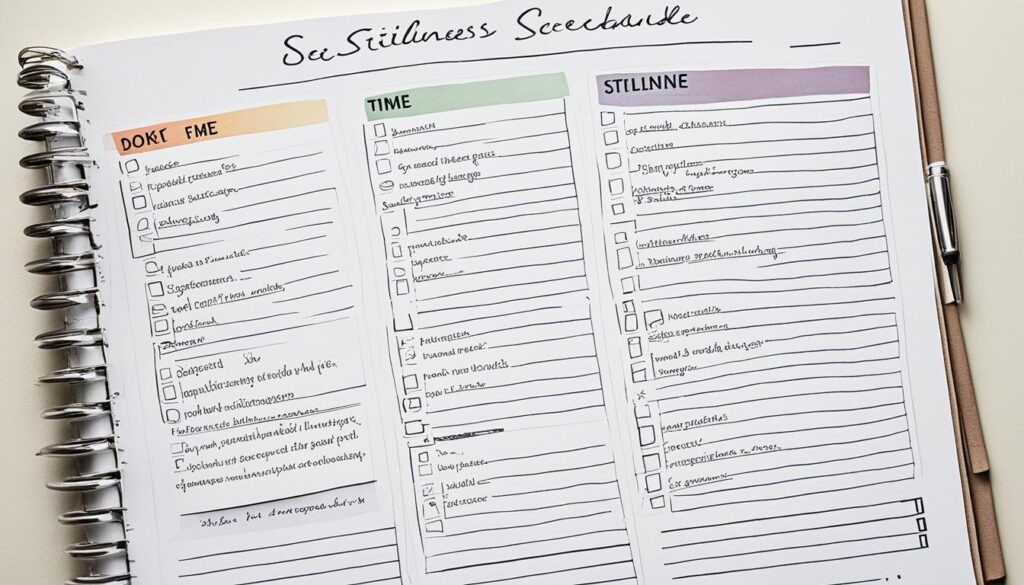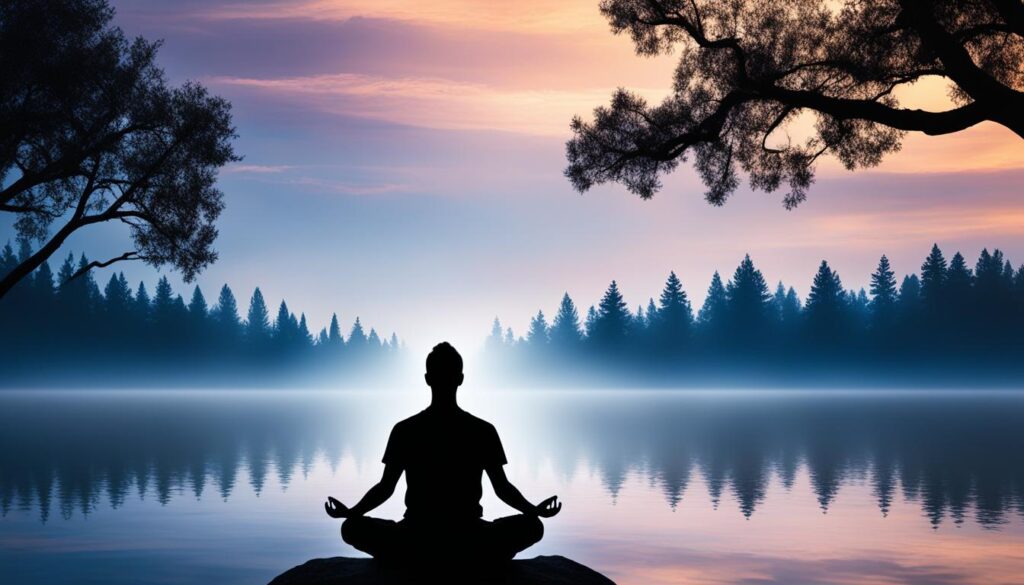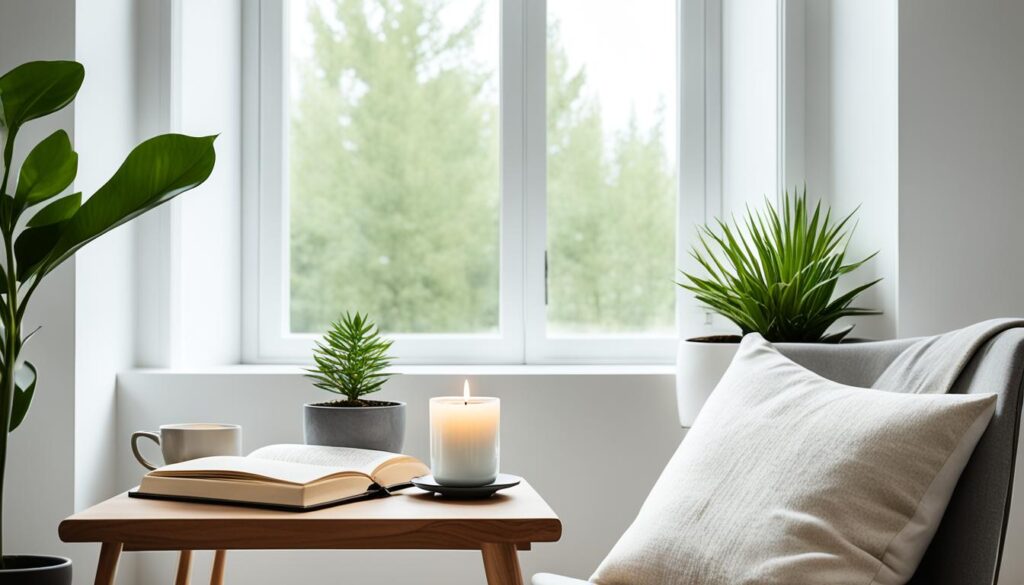In today’s fast-moving society, it may seem difficult to find moments of peace and quiet. We are constantly surrounded by alerts, deadlines, and the stresses of daily life. It can be easy to get overwhelmed by the busyness and forget about our inner tranquility. However, what if I informed you that it is not only achievable but also crucial for our overall health to nurture a sense of calmness?
As a fellow traveler on this journey of life, I understand the challenges we face in finding stillness amidst the noise. I’ve experienced the overwhelm, the racing thoughts, and the unrelenting busyness that can leave us feeling drained and disconnected. But I’ve also discovered the transformative power of stillness and its ability to bring us back to our center.
Practicing stillness is not about escaping reality or avoiding the challenges of life. It’s about creating intentional moments of calm and reflection that allow us to recharge, reconnect with ourselves, and navigate life’s ups and downs with greater clarity and serenity. It’s about finding a sanctuary within ourselves, where we can cultivate peace and find solace in the midst of chaos.
Join me on a journey to cultivate calm and discover the beauty of stillness. In this article, we’ll explore six powerful ways to practice stillness that can fit seamlessly into our daily lives. From focused breathing to finding a favorite spot, each approach offers a unique path to inner peace and tranquility.
Key Takeaways:
- Create intentional moments of stillness to replenish your mind and soothe your nervous system.
- Practice focused breathing to induce a sense of calm and stillness.
- Find stillness in the midst of a busy day by setting aside time and space for reflection.
- Choose a favorite spot that brings you comfort and silence for your stillness practice.
- Enhance your stillness practice by listening to soft music or repeating calming phrases.
The Power of Stillness
Stillness has numerous benefits for our mental health. It allows us to replenish ourselves, hear our thoughts, and soothe our nervous system. Physically slowing down, reducing external stimuli, and creating an intention of stillness are key to experiencing the power of stillness. It can be practiced anywhere and at any time, providing moments of calm even in the midst of a busy day.
In today’s fast-paced world, finding moments of stillness can be a challenge. However, the benefits of incorporating stillness into our daily lives are worth the effort. It gives us an opportunity to pause, recharge, and reconnect with ourselves.
When we embrace stillness, we create space for introspection and self-reflection, which can lead to greater self-awareness and personal growth. By slowing down, we allow our minds and bodies to relax, reducing stress and promoting overall well-being.
Maintaining a practice of stillness can also enhance our mental clarity and focus. The quiet moments of stillness enable us to clear our minds, declutter our thoughts, and gain a fresh perspective on life’s challenges. It allows us to tap into our inner wisdom and make conscious decisions from a place of calmness and clarity.
Moreover, stillness has the power to cultivate resilience and emotional stability. When we practice being present and let go of worries about the past or future, we become more grounded in the present moment. This presence allows us to respond to life’s ups and downs with a greater sense of equanimity and composure.
The mental health benefits of stillness extend beyond our individual well-being. As we develop a practice of stillness, we become more attuned to the needs of others, fostering empathy and compassion. Stillness can deepen our connection with loved ones and the world around us, enhancing our relationships and promoting a sense of interconnectedness.
Let us embrace the power of stillness and make it a part of our daily lives. Through intentional moments of calm and quiet, we can experience the profound benefits that stillness brings to our mental health and overall well-being.
The Mental Health Benefits of Stillness
| Benefits of Stillness | Mental Health Benefits |
|---|---|
| Replenishes the mind and body | Reduces stress and promotes relaxation |
| Enhances self-awareness and personal growth | Improves mental clarity and focus |
| Cultivates resilience and emotional stability | Fosters empathy and compassion |
| Deepens connection with others and the world | Promotes a sense of interconnectedness |
1. Breathe
One way to practice stillness is through focused breathing. When we take slow, deep breaths, it activates our parasympathetic system, which helps to slow down our heart rate and promote relaxation. By intentionally focusing our attention on our breath, we can induce a sense of calm and stillness in both our minds and bodies.
Try this simple breathing exercise to practice stillness:
- Find a comfortable position, either sitting or lying down.
- Close your eyes and take a moment to settle into your body.
- Take a slow, deep breath in through your nose, filling your lungs completely.
- Hold the breath for a moment, allowing yourself to fully experience the sensation of being present.
- Slowly exhale through your mouth, letting go of any tension or stress with each breath out.
- Continue this slow, deep breathing pattern for a few minutes, focusing solely on your breath.
As you practice stillness through breathing, you may notice a sense of peace and tranquility washing over you. This simple yet powerful technique can be practiced anywhere and at any time, making it easily accessible for moments when you need to find calm amidst the chaos of daily life.

Remember, the breath is always with us, serving as an anchor to the present moment. By incorporating intentional breathing exercises into our daily routines, we can tap into the power of the breath to cultivate stillness and promote overall well-being.
2. Practice when you need it
Practicing stillness is not limited to a specific time or place. It can be embraced in the midst of our daily lives, whenever the need arises. Whether you find yourself in the hustle and bustle of the office or seeking solace at home, taking a few precious minutes to practice stillness can provide a much-needed recharge and bring a sense of calm amidst the chaos.
Setting aside dedicated time for stillness, even if it’s just a few minutes each day, is essential. By prioritizing these moments of tranquility, we communicate to ourselves and others that our need for personal quiet time is significant and deserving of respect.
So even in the busiest of days, make it a point to pause, breathe, and find stillness. By doing so, you’ll discover that even a few moments of introspection can have a profound impact on your overall well-being.
“In the midst of movement and chaos, keep stillness inside of you.” – Deepak Chopra
Practicing Stillness in Daily Life
Integrating stillness into your daily life is a powerful way to find balance and create a sense of calm. Here are some tips on how to practice stillness in different areas of your life:
At the Office
- Find a quiet corner or create a personal nook where you can retreat during breaks or when you need a moment of calmness.
- Take short mindfulness breaks throughout the day, focusing on your breath and letting go of any tension or stress.
- Engage in simple stretching exercises or gentle movements to release physical and mental tension.
In Daily Life
- Set aside a few minutes each morning or evening for quiet reflection and meditation.
- Schedule regular breaks during the day to step away from distractions and reconnect with yourself.
- Practice mindful walking or engage in a mindful activity that brings you joy and helps you cultivate stillness.
Incorporating stillness into your daily life may require some intention and effort, but the rewards are worth it. By creating space for stillness, you’re giving yourself permission to slow down, recharge, and find inner peace amidst the demands of everyday life.
| Daily Life | Tips for Practicing Stillness |
|---|---|
| At the Office | Find a quiet corner or create a personal nook where you can retreat during breaks or when you need a moment of calmness. Take short mindfulness breaks throughout the day, focusing on your breath and letting go of any tension or stress. Engage in simple stretching exercises or gentle movements to release physical and mental tension. |
| In Daily Life | Set aside a few minutes each morning or evening for quiet reflection and meditation. Schedule regular breaks during the day to step away from distractions and reconnect with yourself. Practice mindful walking or engage in a mindful activity that brings you joy and helps you cultivate stillness. |

3. Schedule stillness
If spontaneous stillness doesn’t come naturally, scheduling it can be helpful. By setting aside specific time in your day for stillness, you create a dedicated space for calm and quiet. This time should be treated as sacred and honored by both yourself and those around you. You can even set an alarm on your phone to remind yourself to take that moment of stillness.
Scheduling stillness means making stillness a priority. In our fast-paced world, it’s easy to get caught up in the busyness of life and neglect our need for stillness. By consciously setting aside time for stillness, we ensure that it becomes an integral part of our daily routine.
“By scheduling stillness, we create a container for silence and tranquility amidst the chaos of daily life.”
One effective way to schedule stillness is to incorporate it into your morning or evening routine. By starting or ending the day with a few minutes of quiet reflection, you set a peaceful tone for the rest of your day or prepare yourself for restful sleep.

Creating a Stillness Schedule
To make scheduling stillness a regular practice, consider the following tips:
- Choose a specific time: Select a time that works best for you, whether it’s early morning, during lunch breaks, or before going to bed.
- Set realistic expectations: Start with small increments of time, such as 5 or 10 minutes, and gradually increase as you become more comfortable with stillness.
- Create a dedicated space: Find a quiet and comfortable spot where you can immerse yourself in stillness without distractions.
- Turn off notifications: During your scheduled stillness time, silence your phone or put it on airplane mode to minimize external interruptions.
Remember, scheduling stillness is not about rigidly adhering to a strict routine, but rather about making the conscious decision to prioritize moments of calm. It’s about giving yourself the gift of stillness and allowing yourself to recharge, reflect, and find inner peace in the midst of a hectic world.
4. Find a favorite spot
While stillness can be practiced anywhere, finding a favorite spot can enhance the experience. It could be a serene park or a peaceful bench in nature, allowing you to immerse yourself in outdoor stillness. Alternatively, you may prefer to create a cozy nook at home where you can unwind and embrace silence. Having a designated spot that brings you comfort and tranquility can make it easier to settle into the stillness.

Connecting with nature is a powerful way to find stillness. Spending time outdoors provides a sense of calm and allows us to appreciate the beauty of the natural world. Whether it’s sitting by a serene lake, taking a peaceful hike through the woods, or simply finding a quiet spot in a nearby park, immersing ourselves in outdoor stillness can be incredibly soothing.
On the other hand, finding silence at home can be just as rewarding. Create a dedicated space where you can retreat from the noise and distractions of everyday life. It can be a corner of your living room, a cozy reading nook, or even a peaceful meditation room. Fill this space with items that bring you joy, such as comfortable cushions, soft lighting, and calming scents. By deliberately curating this space, you can create an environment that encourages stillness and silence.
Remember, finding a favorite spot is all about creating a space that resonates with you. It should be a place where you can fully relax and let go of the outside world, allowing yourself to be fully present in the moment. Whether you choose an outdoor oasis or a serene corner of your home, make it a priority to discover your own personal sanctuary of stillness.
5. Listen to soft music
Some people find it challenging to be alone with their thoughts, especially when silence can be overwhelming. That’s where soft, slow music can be a great companion for finding stillness within. By listening to gentle and calming background music, you can create a peaceful ambiance and establish a sense of structure in your practice.
Soft music acts as a buffer, preventing the silence from becoming overwhelming and providing a soothing backdrop for your stillness journey. The slow and melodic tunes help to calm the mind and relax the body, allowing you to ease into a state of peacefulness.
Benefits of Using Music for Stillness
When you incorporate soft and slow music into your moments of stillness, you can enjoy a range of benefits:
- Enhances relaxation: Calming background music can deepen your relaxation experience, enabling you to let go of tension and stress.
- Fosters focus: The soothing melodies act as anchors for your attention, helping you to stay present and centered.
- Encourages mindfulness: Soft music invites you to tune in to the present moment, heightening your mindfulness as you engage with the music and yourself.
- Creates a positive atmosphere: The ambiance created by soft music sets the tone for a serene and tranquil experience, making it easier to find stillness within.
Experiment with different genres and artists to find the type of music that resonates with you the most. You may prefer instrumental tracks, nature sounds, or ambient compositions—anything that elicits a sense of calm and peace within you.
“Music is the divine way to tell beautiful, poetic things to the heart.” – Pablo Casals
Let the music be your guide as you embark on your stillness practice. Allow the melodies to carry you into a state of serenity, where you can connect with your inner self and find respite from the noise of the outside world.
| Genre | Description |
|---|---|
| Piano | Melodic piano compositions that evoke tranquility and introspection. |
| Ambient | Subtle electronic soundscape that creates a soothing and ethereal atmosphere. |
| Nature Sounds | Recordings of natural environments such as forests, rainforests, or ocean waves, providing a calming backdrop that connects you with nature. |
| Classical | Elegant and timeless compositions, including pieces from renowned composers like Bach, Mozart, and Debussy. |
| Instrumental | Instrumental tracks from various genres, offering an uplifting and serene musical experience. |

Allow yourself to surrender to the gentle melodies, letting the music guide you to a place of stillness and tranquility within. Remember, the goal is not to focus on the music itself but to use it as a tool to create an atmosphere conducive to stillness and inner peace.
6. Repeat calming phrases
Using calming phrases or affirmations can bring structure and focus to your stillness practice. By repeating soothing self-talk such as “I am calm and still” or “I can create stillness,” you can invite a sense of tranquility into your mind and body. These calming phrases can be directed towards peaceful statements, visualizing a serene image, or even reciting them while taking a slow walk without distractions.
“I am calm and still”
“I can create stillness”
Calming phrases and affirmations act as powerful tools to quiet the mind, redirect negative thoughts, and cultivate a state of inner peace. By integrating positive self-talk into your stillness practice, you can reinforce feelings of calmness and enhance the overall experience.
In addition to affirmations, you can also explore guided meditation or mindfulness apps that provide soothing audio tracks with calming phrases and affirmations. These resources can further support your journey toward stillness and provide additional guidance for finding inner tranquility.

Benefits of using calming phrases for stillness
Using calming phrases or affirmations during your stillness practice offers several benefits:
- Promotes relaxation and reduces stress
- Enhances focus and concentration
- Encourages positive self-talk and self-compassion
- Helps reframe negative thoughts and emotions
- Deepens the sense of presence and mindfulness
By incorporating calming phrases into your stillness practice, you can create a positive inner dialogue, foster a peaceful mindset, and cultivate a greater sense of well-being.
Connect Stillness with Spirituality
Stillness holds profound significance not only for our mental well-being but also in the realm of spirituality. It offers a doorway to the divine, allowing us to connect with higher realms of consciousness. Cultivating stillness in the presence of God can be challenging yet immensely rewarding. In the serenity of stillness, we can find solace, peace, and a deep sense of connection with our spiritual essence.
To find stillness in God’s presence, there are various spiritual practices that can quiet the mind and open the heart:
- Praise and Prayer: Engaging in heartfelt praise and prayer can create a space of stillness within us and align our souls with the divine. Through the power of gratitude and surrender, we can experience a profound sense of peace and connection.
- Meditating on a Passage: Reflecting on sacred texts, verses, or spiritual teachings during moments of stillness can draw us closer to the spiritual realm. Guiding our thoughts towards divine wisdom can help quiet the mind and cultivate a deeper understanding of our spiritual path.
- Using Imagination: Imagination can be a powerful tool for finding stillness in spirituality. By visualizing ourselves in the presence of the divine, we can create a sacred space within our minds and immerse ourselves in a moment of tranquil communion.
- Reciting a Prayer of Stillness: Reciting a prayer specifically crafted for stillness can bring us into a state of calm and receptivity. This silent repetition of sacred words or phrases can anchor our minds, quiet distractions, and evoke a sense of peace in our spiritual practice.
Embracing stillness in spirituality allows us to quiet the noise of the external world and attune ourselves to the whispers of the divine within. It is within stillness that we can deepen our connection, find spiritual nourishment, and experience a profound sense of inner peace and fulfillment.

Make Space for Silent Moments
In a world filled with noise and constant activity, creating space for silent moments is crucial. It allows us to reconnect with ourselves, find inner calm, and cultivate a sense of presence in our daily lives.
One of the ways to prioritize silent moments is by starting the day with inner stillness. Setting aside a few minutes in the morning to engage in quiet reflection, deep breathing, or meditation can help us center ourselves and create a calm foundation for the day ahead.
Another practice that can help us connect with silence is mindful awareness. By being fully present in the current moment, we can observe our thoughts, emotions, and surroundings without judgment or attachment. This practice enables us to experience the richness of each moment and find stillness amidst the busyness of life.
Expressing gratitude throughout the day is another powerful way to create space for silence. By appreciating the small blessings and moments of beauty that surround us, we shift our focus from the noise to the quiet miracles that exist in our lives.
“Silence isn’t empty, it’s full of answers.”
Observing the Magic of Nature
Nature has a way of providing us with moments of stillness and awe. Taking the time to pay attention to our surroundings and connect with the natural world can deepen our experience of silence.
Find a peaceful outdoor spot, whether it’s a park, a garden, or a trail, where you can immerse yourself in the beauty of the environment. Take a moment to listen to the sounds of birds chirping, leaves rustling, or waves crashing. Observe the colors, textures, and intricate details of the natural world. Allow yourself to be fully present in the moment and let the silence of nature envelop you.

The Power of Silent Reflection
Silence provides us with the opportunity to reflect on our thoughts, feelings, and experiences. By dedicating time for silent reflection, we can gain clarity, deepen our self-understanding, and make more intentional choices in our lives.
Consider incorporating journaling into your routine as a way to capture your reflections. Writing down your thoughts, insights, and observations can help you process your experiences, gain new perspectives, and uncover hidden wisdom within.
Remember, creating space for silent moments is not about completely eliminating noise or activity from our lives. It’s about finding a balance between engagement and solitude, between noise and stillness. By prioritizing silent moments, we can nurture our inner calm, cultivate a deeper connection with ourselves and the world around us, and find a sense of peace in the midst of life’s chaos.
Embrace the Breath
The breath is a powerful tool for finding stillness. By becoming conscious of our breath and infusing it with awareness, we can tap into inner stillness and cultivate a sense of calm and tranquility. Conscious breathing allows us to quiet the mind and connect with our life source, creating a space for rejuvenation and reflection.
When we observe the natural rhythm of our breath, we are brought back to the present moment. The act of focusing on each inhale and exhale helps to anchor our attention, releasing us from the distractions of the outside world. The breath acts as a bridge between the chaotic external environment and our inner sanctuary of stillness.

Conscious breathing involves taking slow, deep breaths, allowing the breath to flow naturally and effortlessly. As we inhale, we fill our lungs with fresh oxygen, energizing our bodies and clarifying our minds. And as we exhale, we release tension, stress, and negative emotions, inviting a state of calm and relaxation. It is in the gentle rise and fall of our breath that we can find solace and balance.
Incorporating conscious breathing into our daily lives is a simple but transformative practice. Whether taken as a standalone practice or integrated into other stillness techniques, the breath serves as a powerful anchor that guides us back to the present moment. It is a reminder that amidst the chaos of life, there is always stillness to be found within.
“Breath in, breath out. Allow the rhythm of your breath to guide you into the serenity of stillness.” – Unknown
Reflect and Recharge
As we wind down for the evening, it’s important to reflect on the events of the day and find stillness before bed. By incorporating stillness as part of a nightly routine, we can create a sense of closure and prepare ourselves for a restful sleep. Here are a few activities that can help us reflect and recharge:
- Listening to relaxing music: Before bed, immerse yourself in the soothing melodies of calming music. Allow the gentle notes to wash away the stresses of the day, creating a peaceful atmosphere that promotes stillness and relaxation.
- Journaling: Put pen to paper and journal your thoughts and emotions. Use the power of written words to reflect on the day’s events, express gratitude, and gain clarity. Journaling allows us to process our experiences, enabling us to let go and find inner stillness.
- Practicing restorative asanas: Engage in gentle yoga poses that promote relaxation and rest. Restorative asanas, such as Child’s Pose or Legs-Up-The-Wall, can help release tension in the body, quiet the mind, and create a state of tranquility.
- Expressing gratitude: Take a moment to reflect on the blessings and positive experiences of the day. Cultivating a mindset of gratitude helps shift our focus to the present moment and invites a sense of stillness and contentment.
Incorporating these activities into our nightly routine can foster reflection, recharge our minds and bodies, and encourage a deep state of stillness that prepares us for a peaceful sleep.

Reflecting before bed and embracing stillness as part of our nightly routine is essential for our overall well-being. It allows us to let go of the events of the day, find inner peace, and recharge for the day ahead.
The Beauty of Stillness
Stillness enriches our lives by allowing us to be fully present in the here and now. It is in those moments of silence that we find a deep connection to ourselves and the world around us. By embracing stillness, we can achieve a delicate balance between our inner and outer worlds.
Finding Beauty in Stillness
When we pause and quiet our minds, we open ourselves up to the beauty that often goes unnoticed in our fast-paced lives. In the stillness, we can truly see and appreciate the simple moments that bring us joy, like the sun casting a warm glow through the trees or the sound of rain gently tapping on the windowpane. These small, fleeting moments of beauty remind us of the wonders that surround us.
The Balance of Inner and Outer
Stillness creates a space for us to turn inward and nurture our inner selves. It allows us to reflect, recharge, and find a sense of calm amidst the chaos. By acknowledging our inner world and finding peace within, we can better navigate the demands of the outer world. It is through this delicate balance of inner stillness and outer engagement that we can lead more fulfilled and grounded lives.

The Power of Gratitude
“Gratitude makes sense of our past, brings peace for today, and creates a vision for tomorrow.” – Melody Beattie
In the stillness, we can also cultivate a deep sense of gratitude. When we slow down and appreciate the present moment, we become more aware of the blessings in our lives. Gratitude opens our hearts and brings us closer to a state of contentment and fulfillment.
Moments of Silence
In our noisy world, it can be easy to overlook the importance of silence. However, moments of silence offer a respite from the constant chatter and allow us to truly listen to our inner voice. It is in these moments that clarity emerges, creativity flourishes, and we gain a deeper understanding of ourselves.
Incorporating moments of silence into our daily lives can be as simple as taking a walk in nature without distractions, enjoying a cup of tea in peace, or finding solace in a quiet corner of our homes. These moments of stillness provide an opportunity to recharge and reconnect with ourselves.
Conclusion
Incorporating stillness into our daily lives is essential for cultivating inner peace and finding a sense of calm amidst the chaos. By practicing breathing techniques, scheduling moments of stillness, finding favorite spots, and connecting with silence, we can experience the numerous mental and spiritual benefits that stillness brings.
Embracing moments of stillness allows us to recharge our minds and bodies, giving us the opportunity to reflect on our thoughts and emotions. It helps us navigate through the busyness of life with clarity and tranquility.
By making the conscious choice to incorporate stillness into our daily routines, we open ourselves up to a deeper connection with ourselves and the world around us. It is in these moments of stillness that we can truly find peace and fulfillment.
Can Ignoring Someone Respectfully Help in Cultivating Calm and Stillness?
When used wisely, strategic tips for ignoring can indeed help in cultivating calm and stillness. By choosing to respectfully ignore someone, you can avoid unnecessary conflict or tension, allowing yourself to focus on more important matters and maintaining a sense of peace in your surroundings.
FAQ
What are the benefits of practicing stillness?
Practicing stillness has numerous benefits for mental health. It allows us to replenish ourselves, hear our thoughts, and soothe our nervous system. It can be practiced anywhere and at any time, providing moments of calm even in the midst of a busy day.
How can I practice stillness through breathing?
One way to practice stillness is through focused breathing. Taking slow, deep breaths activates the parasympathetic system and slows the heart rate. By intentionally focusing on our breath, we can induce a sense of calm and stillness in our minds and bodies.
How can I incorporate stillness into my daily life?
You can practice stillness anytime and anywhere. Whether you’re in the office or at home, taking a few minutes to practice stillness can help you recharge and find calm amidst the chaos. Setting aside specific time for stillness, even if it’s just a few minutes, can make it a priority and allow others to respect your need for personal quiet time.
How can I schedule stillness in my day?
If spontaneous stillness doesn’t come naturally, scheduling it can be helpful. By setting aside specific time in your day for stillness, you create a dedicated space for calm and quiet. This time should be treated as sacred and honored by both yourself and those around you. You can even set an alarm on your phone to remind yourself to take that moment of stillness.
Where can I practice stillness?
While stillness can be practiced anywhere, having a favorite spot can enhance the experience. It can be a peaceful outdoor location like a park or a bench, or it can be a quiet corner of your home. Being in a place that brings you comfort and silence can help you settle into the stillness more easily.
How can soft music help with stillness?
Some people find it challenging to be alone with their thoughts, which is where soft music can be helpful. Listening to gentle, slow music can provide a sense of structure and prevent the silence from becoming overwhelming. It can create a peaceful ambiance and aid in finding stillness within.
How can I incorporate calming phrases into my stillness practice?
Using calming phrases or affirmations can bring structure to the stillness practice. By repeating phrases like “I am calm and still” or “I can create stillness,” you can focus your mind and invite a sense of calmness. These phrases can be directed towards peaceful statements, a soothing image, or even used while taking a slow walk without distractions.
How can I connect stillness with spirituality?
Stillness is not only beneficial for mental health but also plays a significant role in spiritual practices. Cultivating stillness in the presence of God can be challenging but rewarding. Whether through praise and prayer, meditating on a passage, using imagination, or reciting a prayer of stillness, finding moments of quiet communion with the divine can bring peace and refreshment.
How can I make space for silent moments in my life?
In a world filled with noise and constant activity, creating space for silent moments is crucial. Starting the day with inner stillness, practicing mindful awareness, and expressing gratitude throughout the day can help us reconnect with silence. Paying attention to our surroundings and observing the magic of nature can also bring us into deeper moments of presence.
How does the breath help in finding stillness?
The breath is a powerful tool for finding stillness. By becoming conscious of our breath and infusing it with awareness, we can calm the mind, energize the body, and connect with our life source. Observing the natural rhythm of our breath can bring us back to the present moment and access inner stillness.
How can I reflect and recharge with stillness?
Ending the day with reflection and rest can help us let go of the events of the day and return to silence and stillness. Engaging in activities like listening to relaxing music, journaling, practicing restorative asanas, and expressing gratitude can create a sense of closure and prepare us for a restful sleep.
How does stillness bring balance and beauty to life?
Stillness enriches our lives by allowing us to be fully present in the here and now. Balancing inner and outer silence, recognizing our connection to the world around us, and cultivating gratitude can bring greater fulfillment. Stillness provides a refuge from the noise of daily life and offers a gateway to deeper presence and understanding.
Augustus is the visionary leader and Editor-in-Chief of Personality-Test.net. With an unwavering commitment to quality and authenticity, he oversees all content, ensuring it enlightens and empowers our audience. Augustus believes deeply in the transformative power of self-awareness and is dedicated to making Personality-Test.net a beacon for those on a journey to understand themselves better.










